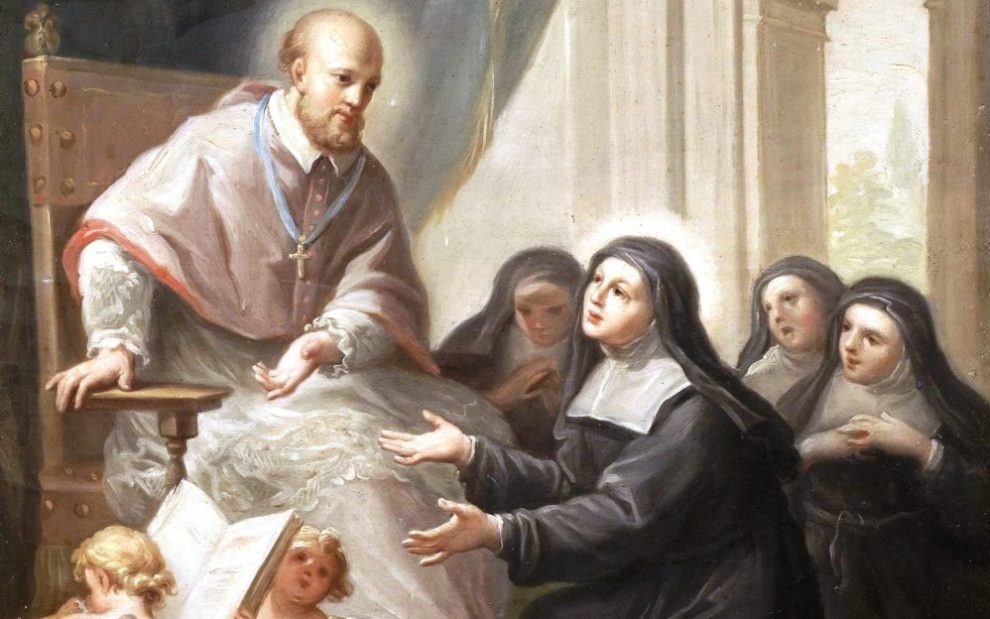“Be at peace and let your weary, listless heart rest against the sacred, loving breast of this Savior, who by his providence is a father to his children, and by his gentle, tender love is a mother to them.” —St. Francis de Sales
I first “met” St. Francis de Sales in a roundabout sort of way. In the early 1970s, I began researching Jane de Chantal, an early modern Catholic widow and foundress of a religious community known as the Visitation of Holy Mary. I knew Jane had co-founded her community with the Savoyard Bishop Francis de Sales, but it was not until I began research in earnest that he impinged on my consciousness.
Because she did not write for publication, I had to search Francis’ writings to get a glimpse of Jane. Over the years I read and re-read his side of their almost two decade-long correspondence. It was almost as though I was receiving the letters myself.
Steeped in the classics, theology, philosophy, and spirituality, Francis served as a priest and later bishop in Geneva, where he is credited with restoring Catholicism following John Calvin’s Reformation. In an era when theologies of predestination were in vogue, warning that God predestines some to eternal damnation, Francis came to believe that God desires that all be saved.
Reading his letters, I came to see that Francis saw the universe as a world of interconnected hearts: our hearts and God’s generous heart bridged by the gentle, humble heart of Jesus (Matthew 11:29). God desires that we love each other as we have been loved. We don’t have two hearts, Francis was wont to say, one that loves God and one that loves others. We have only one heart that loves in varying ways.
Such a message was hardly restricted to the early 1600s. Love is realized as we look around us. It occurs in marriages, families, classrooms, and workplaces. It occurs especially in friendships based on a shared sense of God-with-us.
Love becomes concrete by the practice of the “little” relational virtues of gentleness, humility, patience, simplicity, and cordiality. Francis believed that these virtues could be practiced in every walk of life, whether one was a homemaker, merchant, teacher, student, or priest.
Reading his correspondence, I was, like Jane de Chantal, led into a process of spiritual formation. I was encouraged to be gentle with myself as well as with others. I learned to “love my abjections” or limitations—at first an off-putting thought. I came to see, however, that my weaknesses and shortcomings were the very things that bring me close to others.
Through embracing my human vulnerability, I’ve learned to “live between the two wills of God,” as Francis described it. Though God’s full intent is not accessible to us, there are two avenues through which a partial glimpse is possible: “God’s will to be done” is discovered in the process of discernment, while “God’s will done” is found in our circumstances.
Though I had learned of these ideas in Francis’ letters, the saint seemed to think I had more to learn. It was only in trying to publish a book—on Salesian spirituality nonetheless—that I began to understand Francis’ teaching on “two wills.”
Having submitted a number of cover options created by Salesian artists, my colleagues and I were upset to discover that our publisher had commissioned an outside artist to create the cover of our book. This would not have been so terrible, but once we viewed the commissioned piece, we were nonplussed.
The piece depicted our saints as we had never seen them, sort of like Hollywood movie stars, staring dreamily off into the distance. They were unrecognizable. The historian among us couldn’t get over the cheesy smiles: Seventeenth-century portraits never show teeth!
One of my colleagues attempted to change the publisher’s mind, but to no avail. We were curtly told that if we didn’t like the cover, the book would never see the light of day. Needless to say, we adjusted and let it go.
Though this example is trivial, the point is—and this I have found very helpful in more serious situations—that neither our sense of what should be, nor what had to be, was the full will of God. Each was only a glimpse.
Our task is to learn to live flexibly and generously between what we sense as God’s call and the challenging or seemingly impossible circumstances in which we find ourselves. The art of it is, on the one hand, to avoid being too attached to what we sense God calls us to do, all the while being wholly committed to its realization; and on the other hand, to avoid being too thoughtlessly conformed to the circumstances in which we find ourselves, while still embracing them generously.
Francis de Sales, through this first little lesson and more profoundly in the intervening years, has been for me a wise mentor, teaching me to live with energy in what seems to be called for, and yet to be willing to change course and remain generous in something different and new.
This article also appears in the June 2009 issue of U.S. Catholic (Vol. 74, No. 6). Click here to subscribe to the magazine.
Image: Wikimedia Commons/San Francisco de Sales by Francisco Bayeu y Subias













Add comment